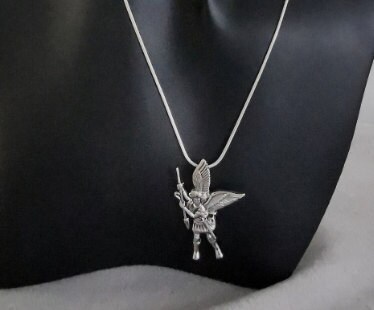Archangel Michael is one of the most revered figures in religious and spiritual traditions worldwide. He is often depicted as a mighty warrior, clad in armor, wielding a flaming sword, and standing triumphant over the forces of darkness. His name, derived from Hebrew, means "Who is like God?"—a rhetorical question that emphasizes his divine power and unwavering faithfulness to God’s will. Whether in Christianity, Judaism, Islam, or various esoteric traditions, Michael is celebrated as a protector, leader, and symbol of courage.
Archangel Michael first appears in ancient Jewish texts, particularly in the Book of Daniel, where he is described as the protector of Israel. His role as a warrior and leader of God's armies is reinforced in Christian and Islamic traditions. In Christianity, particularly in the New Testament, he is often seen as the one who leads the heavenly forces against Satan, most notably in the Book of Revelation. The Quran also refers to Michael (Mikail) as an important angel who assists in divine providence. While the Islamic tradition does not emphasize his role as a warrior, he is still regarded as a powerful being who ensures the sustenance and protection of humanity.
One of the most iconic depictions of Michael comes from the Book of Revelation (12:7-9), where he leads an army of angels in a celestial battle against Satan and his rebellious forces. This imagery has inspired countless works of art and literature, reinforcing Michael's image as a fearless protector of righteousness. Christian iconography often portrays him slaying a dragon, symbolizing the ultimate triumph of good over evil. This representation is deeply ingrained in religious traditions, serving as an inspiration for those who seek strength and protection in the face of adversity. Many believers pray to Michael for courage and defense against spiritual and physical dangers.
In Christianity, Archangel Michael is widely venerated across various denominations. The Catholic Church recognizes him as a saint and the leader of all angels. His feast day, known as Michaelmas, is celebrated on September 29. Many churches and shrines around the world are dedicated to him, emphasizing his role as a protector and healer. Orthodox Christianity also honors Michael as the chief warrior of God. The Eastern Orthodox tradition celebrates him on November 8, alongside other archangels, in a festival known as the Synaxis of the Archangel Michael. Protestant denominations, though less focused on angelic veneration, still acknowledge Michael’s role as a heavenly warrior and protector of God's people. Many believers turn to his biblical appearances for inspiration and strength.
Judaism In Jewish tradition, Michael is seen as the guardian angel of Israel and a principal advocate for God's people. He is often depicted as the angel who stands up for the righteous and ensures divine justice. In rabbinic literature, Michael is sometimes contrasted with other angels who serve different functions, emphasizing his unique role as a defender against evil forces.
Islam In Islam, Mikail (Michael) is considered one of the four chief angels, alongside Jibril (Gabriel), Israfil, and Azrael. While he is not depicted as a warrior, he plays a significant role in sustaining human life by overseeing nature and distributing divine blessings, such as rain and nourishment. His presence in Islamic theology highlights the interconnectedness of angelic duties within God's creation.
Beyond religious texts, Michael's influence extends into literature, art, and modern media. He appears in countless paintings, such as those by Renaissance masters like Raphael and Guido Reni, where he is shown defeating Satan. His image has also been immortalized in sculptures, stained glass windows, and church frescoes. In contemporary culture, Michael continues to be a figure of fascination. Books, movies, and television series often depict him as a celestial warrior, sometimes reimagined in fantasy or science fiction settings. His archetype—representing justice, strength, and divine intervention—remains a powerful symbol in storytelling.
Many people turn to Archangel Michael for guidance, protection, and healing. Prayers dedicated to him often seek his assistance in overcoming personal struggles, defending against evil, or providing strength in difficult times. The famous St. Michael Prayer, composed by Pope Leo XIII in the 19th century, is still recited by millions worldwide as a means of spiritual defense. Michael is also associated with exorcisms and spiritual warfare. In Catholic tradition, he is invoked during blessings and rites of exorcism to help expel demonic influences. His role as a protector extends beyond individual prayers, as many police officers, soldiers, and emergency responders regard him as their patron saint.


